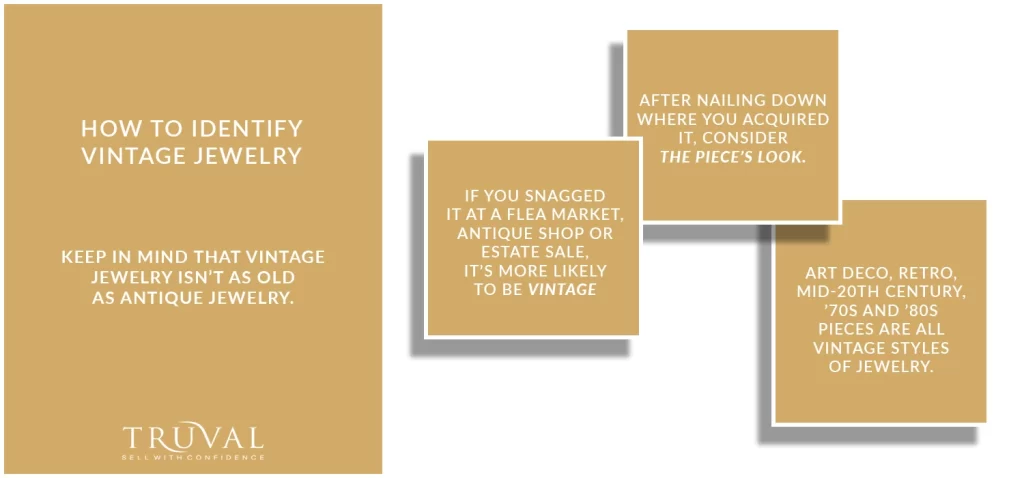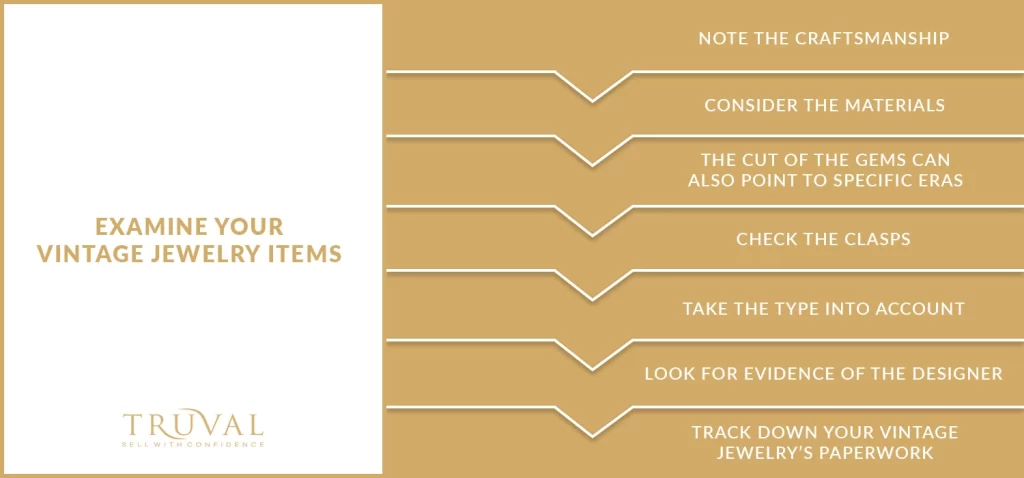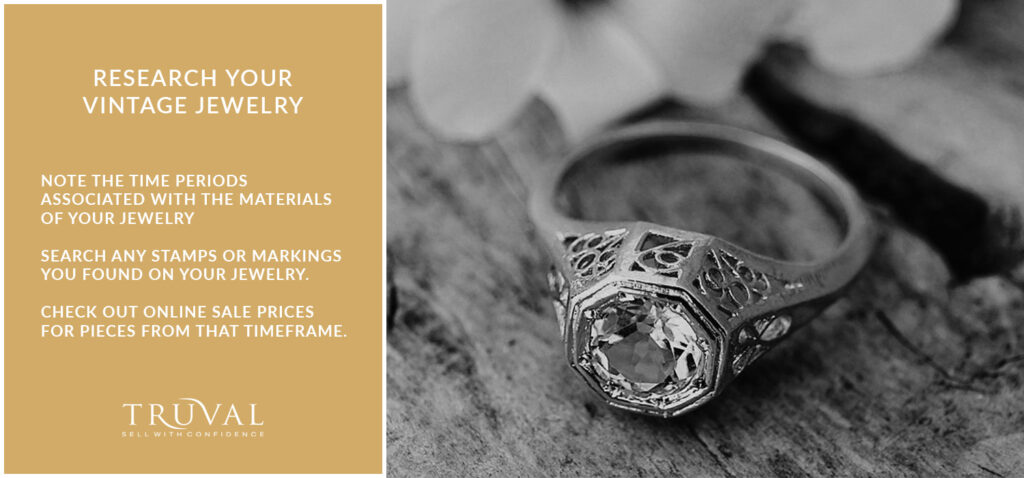Perhaps you once loved those filigree earrings, that diamond watch, the sparkling ring, or your fancy dangling bracelet. Now, however, they’ve lost their appeal. Maybe they don’t fit your style anymore or remind you of an ex-love you’d rather never think about again. Or they could’ve been a gift from a distant relative.
Vintage jewelry you never wear is a wonderful opportunity for making some cash — but you might wonder how to identify vintage jewelry and determine its worth.
We’ve put together the ultimate guide on how to identify vintage costume jewelry and how to assess the value of that vintage jewelry. There are several vintage jewelry identifiers you can use to figure out whether what you own is, in fact, vintage jewelry.
Get an appraisal on your jewelry NOW!
1. Identify Vintage Jewelry
You might own several pieces of both fine and costume jewelry, but you might not be sure what you’ve got. Let’s look at surefire vintage jewelry identifiers.

- Think about where you bought it. If you remember picking it up at a big-box retailer in the last few years, it’s probably not vintage. If you snagged it at a flea market, antique shop or estate sale, it’s more likely to be vintage. It may even be rare valuable costume jewelry!
- After nailing down where you acquired it, consider the piece’s look. There have been a plethora of styles of jewelry crafted in the last century. The time period is a good vintage jewelry identifier. If your piece of jewelry fits into one of those categories, it could be vintage. Art deco, retro, mid-20th century, ’70s and ’80s pieces are all vintage styles of jewelry.
Keep in mind that vintage jewelry isn’t as old as antique jewelry. For a piece of jewelry to be considered vintage, it must be at least 20 years old. Once a piece has its 100th birthday, it’s considered an antique and might be even more valuable.
2. Examine Your Vintage Jewelry Items
One of the most important things to do when trying to determine the value of your vintage jewelry is to examine it closely.

- Note the craftsmanship. Large-scale manufacturing processes that became popular in the middle of the last century made it easier to create jewelry quickly and in large quantities. When looking at your vintage jewelry, see if the piece shows signs of being handmade. Keep in mind, however, that even if it’s not crafted by hand, it could still be valuable. A good portion of vintage jewelry was mass-produced in the 1940s and ’50s.
Don’t just look at the top side of the piece. Turn it over and check out the detail on the underside. High-quality pieces are nicely finished from top to bottom.
- After looking at the craftsmanship, consider the materials. A vintage and antique jewelry identification guide always focuses on materials. A popular vintage and antique jewelry value estimator deals with the materials used to make the piece. Vintage jewelry might consist of fine materials such as diamonds, sapphires, gold and platinum, or it might feature less expensive materials, such as silver, rhinestones and amethysts. Use a magnifying glass to search for marks inside the piece. If it’s made from gold, platinum or silver, it will have a stamp. The material the vintage jewelry is made from can make literally thousands of dollars of difference in its value.
- The cut of the gems can also point to specific eras. For example, “old mine cut” and “European cut” diamonds are no longer produced. These old cuts can also identify the era the jewelry was crafted in, and they often raise the value of the piece. Look at the shapes and cuts of the stones.
- Check the clasps. The types of clasps used on necklaces, pins and bracelets can indicate certain time periods — as can the posts on earrings. Bracelets and necklaces might be vintage if they have box clasps or ring clasps. Today’s popular lobster clasp wasn’t widely used until the 1970s. Brooches and pins, which were wildly popular during past decades, feature different latches, such as C clasps and trombone clasps. Your piece’s fasteners can help you estimate its worth.
- Take the type into account. Styles and trends changed dramatically during the 20th century. Is the piece of vintage jewelry big and bold with bright colors, or is it delicate and demure? The overall look of the piece can help pinpoint both when it was made and its value. For example, during the mid-20th century, styles were extravagant, with larger pieces and brighter colors being the rage.
- Look for evidence of the designer. The designer is an important vintage jewelry identifier that can make the worth skyrocket. Several vintage designers remain popular to this day: Tiffany, Chanel, Christian Dior, Hobe, Cartier and Bulgari, among many others. Some of these brands marked their pieces with logos. Scour your vintage jewelry piece to see whether you can find a designer’s signature, as this could increase the worth exponentially.
Sell your designer vintage jewelry NOW
- Track down your vintage jewelry’s paperwork. If you bought the piece at an estate sale or inherited it, it’s possible that certification paperwork exists somewhere. Authentication helps determine the value of your vintage jewelry. Look through old papers, dig through your attic, ask your relatives, and call the place where you purchased it to see whether you can get your hands on any kind of authentication. Other items that lend to a piece’s value are special bags, boxes or cases. For example, if it’s in a little turquoise box with a white ribbon, you might be the owner of a piece of jewelry from Tiffany.
Closely examining your piece of jewelry and tracking down any existing certificates of authenticity might take time, but it’s critical to figuring out the worth of your jewelry.
3. Research Your Vintage Jewelry

Get online and visit sites that offer vintage and antique jewelry valuation services. There are several trustworthy resources that can help you estimate your vintage jewelry’s value. Find a vintage and antique jewelry identification guide to get you started.
- Look for photos of latches, clasps and markings that are similar to those on the jewelry you own. Note the time periods associated with those materials.
- Search any stamps or markings you found on your jewelry. You might hit the jackpot and find it’s the signature of a famous vintage jewelry designer!
- Check out online sale prices for pieces from that timeframe. Popular sites can give you a broad idea of how much your jewelry could be worth.
Even with an idea of your vintage jewelry’s value, you still have one thing left to do.
4. Find A Buyer
The most priceless heirloom in the world isn’t worth much if you can’t find a buyer to purchase it. Selling it yourself on Craigslist or eBay won’t usually snag you the best price and can be quite a hassle. Talk with a professional, experienced jewelry buyer and get their recommendation. They will most likely want to examine the piece themselves and then offer you an appraisal. This service typically costs a nominal fee, but they can help you sell your vintage jewelry simply and safely, while pulling in the most money possible.
Knowing how to identify vintage jewelry is the first step toward selling those unworn pieces you have filling your jewelry box. Whether you have rare valuable costume jewelry, designer vintage jewelry or even an unknown piece, it could be worth much more than you expect. Looking closely at the piece helps you know exactly what you have and figure out how to estimate the piece’s value. Do some research and find any hard evidence of authenticity, then contact Truval to make sure you get top dollar for your piece.
